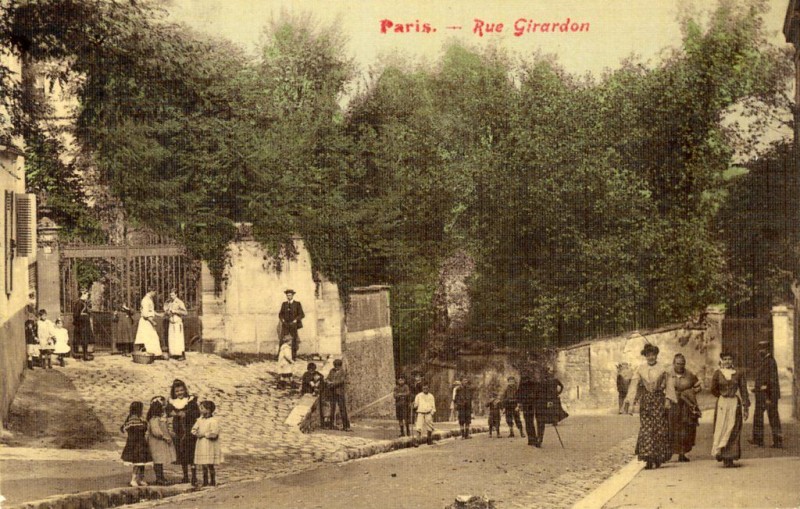
Le Château des Brouillard est une très ancienne demeure Montmartroise dont le nom évoque ce parfum de mystère qui forge les grandes légendes. Cet endroit traversera trois siècles au cours desquels elle connaîtra prestige et décadence.
L’histoire prend sa source à la fin du XVIIIe siècle. La Butte était alors recouverte de vignes et de moulins. En lieu et place de l’actuel château, se trouvait un vaste terrain au milieu duquel, un vieux Moulin des Brouillards tombait en ruines. L’ensemble sera acquis en 1772 par un certain Legrand-Ducampjean, avocat au Parlement. Il rasera les vestiges et mettra à profit ses 7000 m2 nouvellement acquis pour bâtir une « Maison des Brouillards ». Cette appellation viendrait du fait que cette zone, alors très isolée au nord de la Butte, était propices aux brumes matinales.
L’urbanisation de ce secteur ne débutera qu’à partir de 1850. La maison deviendra château, puis passera de mains en mains au début du XIXe siècle. Le poète Gérard de Nerval y résidera entre 1828 et 1833, période au cours de laquelle il écrira de très belle lignes le long desquelles il déplorait déjà la disparition du Montmartre viticole d’antan.
Suivra une longue période au cours de laquelle les lieux seront laissés à l’abandon. Durant toute la seconde moitié du XIXe siècle, le Château des Brouillards et ses alentours seront squattés par divers artistes et marginaux. À cette période, les anciennes dépendances seront rasées pour laisser la place à plusieurs maisons individuelles. Ces endroits hébergeront des personnalités comme le peintre Renoir, et beaucoup plus tard, Jean Cocteau et Jean Pierre Aumont.
À la fin des années vingt, un projet de jonction des rues Simon Dereure et de l’Abreuvoir menacera le domaine. La zone sera finalement préservée et déclarée non aedificandi grâce à l’action notable du propriétaire Victor Perrot, appuyé par La Société du Vieux Montmartre. Perrot passera de longue années à remettre l’ensemble en état, se basant sur des gravures d’époque. L’allée des Brouillards, sera conçue dans la foulée en 1929.
Un livre de Roland Dorgelès écrit en 1936, rend hommage à ces lieux qu’il compare volontiers à la demeure d’un enchanteur.
.
Château des Brouillards (Mansion of the Fogs), whose mysterious name has inspired many a legend, is one of Montmartre’s older residences. During its three centuries on the hill, it has seen both great prestige and even greater decadence. The Château’s history begins in the 17th century, back when the hill of Montmartre was still covered in vineyards and windmills. The site was occupied by a vast parcel of land, in the middle of which stood the ruins of the ‘Moulin des Brouillards’ (Windmill of the Fogs).
M. Legrand-Ducampjean, a parliamentary solicitor, bought the 7,000 metre2 (23,0002 foot) site in 1772 to build his ‘Maison des Brouillards’ (House of the Fogs). The persistence of ‘fog’ in the property titles stemmed from the fact that this area on the north side of the hill, quite isolated at the time, was often draped in a blanket of mist in the early morning. Urban development did not reach this part of Montmartre until 1850. With time, the ‘Maison’ grew into a ‘Château’, and changed hands several times during the nineteenth century. The poet Gérard de Nerval lived here between 1828-1833, a period during which he wrote beautiful long verses about the disappearance of the rural Montmartre he once knew.
The building ws then left in a state of abandon for the entire second half of the 19th century, eventually becoming home to squatters and artists. Around the same time, the Château’s outbuildings were demolished to make way for numerous individual residences, many of which were occupied by famous figures such as Renoir, and later Jean Cocteau and Jean Pierre Aumont.
At the close of the 1920s, a project to link up the Rue Simon Dereure and Rue de l’Abreuvoir threatened to demolish the building, but it was eventually saved by the intervention of its proprietor Victor Perrot, urged on by the Society of Old Montmartre. Perrot spent years renovating the building, basing his reconstruction work on old etchings of the original estate. The Allée des Brouillards was also put in place during this time, opened in 1929.
A 1936 book by Roland Dorgelés pays homage to the Château, comparing it to an enchanter’s palace.
LOCALISER / LOCATE





